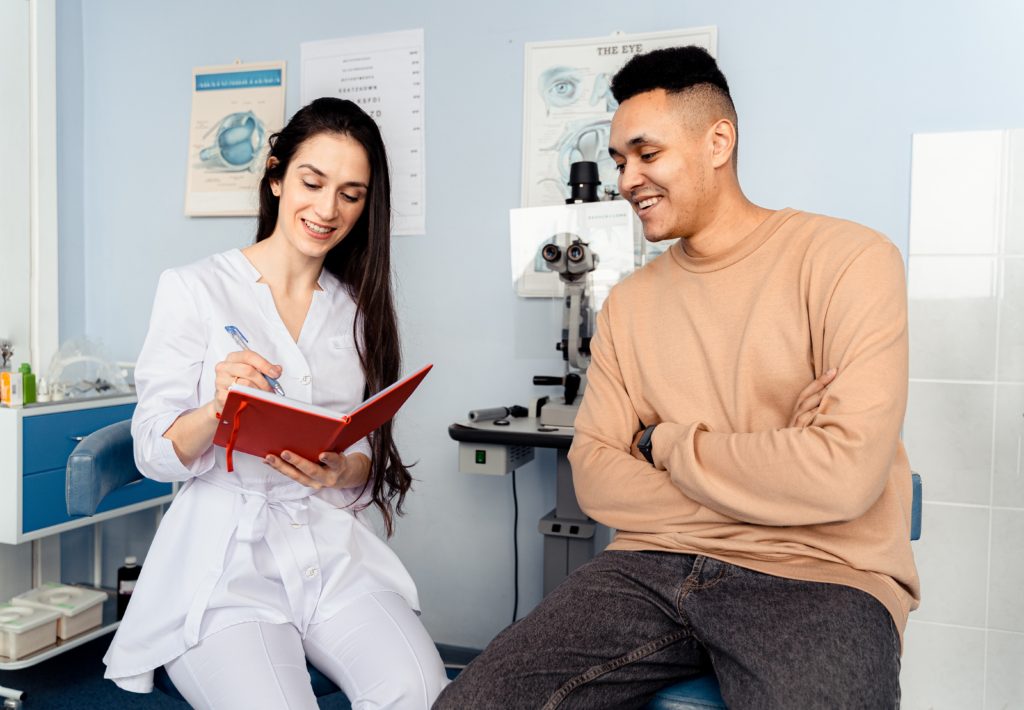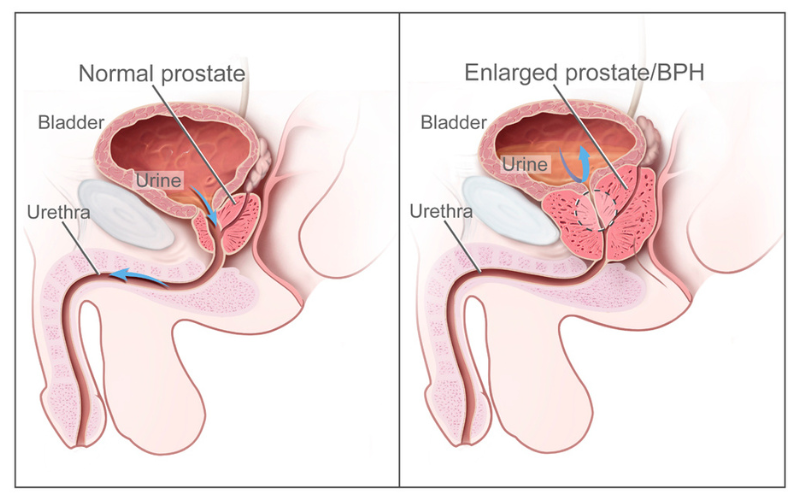
Enlarged prostate, also known as benign prostatic hyperplasia (BPH), is a condition where the prostate gland becomes enlarged and may cause problems with urination and other symptoms. The prostate is a small gland that surrounds the neck of the bladder and urethra in men. As men age, the prostate tends to grow larger. BPH is extremely common and affects up to 50% of men by age 60 and up to 90% of men by age 85.
What Causes Enlarged Prostate?
The prostate enlargement is caused by a natural process that occurs in many aging men. Here are some key points about what leads to an enlarged prostate:
- As men age, the hormone testosterone gets converted by the prostate into dihydrotestosterone, or DHT. This leads to prostate cells multiplying and the gland enlarging.
- Benign prostatic hyperplasia is not cancerous. The extra prostate tissue is benign, meaning it is not malignant.
- Enlarged prostate is also not caused by any infection of the prostate.
- DHT causes the prostate gland cells to rapidly multiply. This proliferation leads to the enlargement, also called hyperplasia.
- The inner part of the prostate squeezes the urethra as it enlarges, leading to urinary symptoms.
- Risk factors that make developing enlarged prostate more likely include:
- Age – very common after age 50, with increasing frequency in older age groups.
- Family history – having a blood relative like a brother or father with BPH increases risk.
- Obesity – being overweight leads to higher levels of hormones like DHT.
- Heart disease
- Diabetes
- Lack of exercise
- Enlarged prostate tends to develop gradually over years. Most men will not experience sudden enlargement or acute symptoms.
- The enlargement is generally benign and more of a quality of life issue, not a fatal condition. But it can still have a significant impact on daily living and health.
- In some cases, BPH that blocks urine flow may lead to bladder damage, urinary tract infections, kidney damage or bladder stones if left untreated. So it is important to see a doctor.
- Medications like finasteride and dutasteride work by preventing the conversion of testosterone into DHT, thereby stopping prostate enlargement.
Signs and Symptoms of Enlarged Prostate
As the prostate grows larger with age, it can constrict the urethra and put pressure on the base of the bladder. This leads to a variety of urinary symptoms, which are usually the first and most obvious signs of enlarged prostate or BPH. Common urinary symptoms and issues caused by an enlarged prostate include:
- Urinary hesitancy – difficulty initiating urine flow, taking a long time to start voiding
- Weak urine stream – the flow and force of urine is reduced
- Straining or pushing to start urinating – having to make an effort to initiate voiding
- Dribbling – urine leaks out after urinating due to incomplete emptying of the bladder
- Urgency – a sudden compelling urge to pass urine
- Increased urinary frequency – feeling the need to urinate more often or passing more urine
- Nocturia – excessive urination at night, having to get up repeatedly to urinate
- Incomplete emptying – not being able to fully empty the bladder after voiding
- Urine retention – inability to pass urine at all, requiring medical attention
- Overflow incontinence – when the bladder cannot fully empty and leaks overflow urine
- Pain or burning during urination – irritation of urethra and bladder by urine
- Blood in urine – may indicate infection or bladder stones
- Erectile dysfunction – inability to get or maintain an erection, about 50% of men with BPH develop erectile dysfunction
Symptoms can range from mild to severe. Mild symptoms may only cause minor nuisance, while advanced cases result in chronic and disabling urinary problems, incontinence, and complications. Seeking medical advice promptly after onset of symptoms allows proper management to minimize impact on quality of life.
Some warning signs that warrant urgent medical attention for enlarged prostate include:
- Inability to pass any urine at all
- Painful burning sensations when urinating
- Fever and chills along with urinary symptoms
- Bloody or cloudy urine
- Bladder stones
- Kidney dysfunction

Diagnosing Enlarged Prostate
Enlarged prostate is usually diagnosed by a doctor after taking a medical history, performing a physical exam, and ordering some tests. Common diagnostic approaches include:
- Medical history – The doctor will ask about urinary symptoms, onset and severity. Family history may be relevant.
- Physical exam – A digital rectal exam allows the doctor to feel the size and shape of the prostate gland. An enlarged, irregular prostate indicates BPH.
- Urine test – Lab analysis of the urine can check for signs of infection like leukocytes and bacteria.
- Prostate specific antigen (PSA) blood test – This measures the level of PSA in the blood. Elevated levels may indicate enlarged prostate, but alone does not definitively diagnose BPH.
- Ultrasound – An ultrasound probe placed in the rectum sends out sound waves to visualize the prostate. Non-cancerous BPH produces a distinct image.
- Cystoscopy – A thin flexible scope is inserted into the urethra to view the inside of the prostate and look for blockage.
- Urodynamic tests – These measure the pressure inside the bladder and urine flow rate. It can help identify obstruction caused by enlarged prostate.
- Bladder scan – Uses ultrasound to see if any urine is retained after voiding, indicating poor emptying.
These medical tests allow doctors to confirm if BPH is present, assess the size of enlargement, check for other conditions like infection, and evaluate the severity of urinary obstruction. This guides appropriate treatment.
Treatment Options for Enlarged Prostate
There are several ways to treat enlarged prostate including:
1. Watchful Waiting and Lifestyle Changes
- If symptoms are mild, simply monitoring and waiting before intervening may be recommended.
- Lifestyle adjustments like limiting fluids before bed, stopping caffeine, and double voiding can provide relief in early stages.
- Regular exercise and maintaining healthy body weight may slow prostate growth.
2. Medications
- Alpha blockers – These medications relax the smooth muscles of the prostate and bladder neck to improve urine flow. Examples: terazosin, doxazosin, tamsulosin, alfuzosin.
- 5-alpha reductase inhibitors – These drugs shrink the enlarged prostate by blocking the conversion of testosterone into DHT. Finasteride and dutasteride.
- Combination drugs – Contain both an alpha blocker to relax muscles and 5ARI to reduce prostate volume for dual action relief.
3. Minimally Invasive Procedures
- Transurethral needle ablation – Using heating provided by radio-frequency energy, needles inserted through the urethra destroy excess prostate tissue.
- Transurethral microwave thermotherapy – A catheter emits microwave heat to destroy prostate tissue and shrink the enlarged gland.
- Prostatic urethral lift – Tiny implants are placed to lift and hold prostate tissue out of the way, opening the urethra for improved flow.
- Interstitial laser coagulation – Laser probes inserted into the prostate deliver high energy to destroy tissue in small segments of the gland.
4. Surgical Interventions
- Transurethral resection of prostate (TURP) – The gold standard and most common BPH surgery. A scope inserted in the urethra uses a wire loop to slice away excess prostate tissue obstructing urine flow.
- Open prostatectomy – Major surgery done through an abdominal incision to remove prostate tissue. Used for very large prostates over 100 grams.
- Holmium laser ablation – A powerful holmium laser inserted through the urethra vaporizes obstructing prostate tissue piece by piece.
- Photoselective vaporization (PVP) – A high energy green light laser vaporizes obstructing prostate tissue to open the urethra. Less bleeding risk than TURP.
- Prostatic artery embolization – Tiny beads injected into the prostate’s blood supply cuts off oxygen to shrink the gland.
5. Alternative Therapies
- Saw palmetto – Extract of the fruit of this small palm tree. Shown to provide mild relief of urinary symptoms in some studies.
- Pygeum africanum – Derived from the bark of the African plum tree. May help urine flow and nocturia.
- Stinging nettle – Extract of the root of this plant has anti-inflammatory properties that may reduce prostate swelling.
- Cernilton – Pollen extract that can strengthen bladder muscles and support prostate health.
Talk to your urologist about which enlarged prostate treatment options may be most appropriate for your symptoms and health status.
Tips for Managing Enlarged Prostate Symptoms
Making certain lifestyle changes and trying some daily habits can help manage urinary symptoms caused by an enlarged prostate:
- Limit fluid intake in the evenings to reduce nighttime urination
- Avoid alcohol and caffeine as they can overstimulate the bladder
- Practice double voiding – urinate fully, relax for a bit, and try to go again; this helps empty the bladder more completely
- Stay physically active through regular exercise like brisk walking or swimming to help control weight and improve overall health
- Maintain a healthy weight as obesity leads to higher concentrations of hormones that exacerbate BPH
- Take any prescribed BPH medications properly and continue over the long-term as directed
- Use the bathroom as soon as the urge to urinate arises; do not delay
- Always urinate from a seated position to allow more complete emptying
- Consider adding dietary supplements like saw palmetto, pygeum or stinging nettle which may offer symptom relief
- Avoid antihistamines, decongestants and cold medicines which can aggravate urinary difficulties
- Monitor for any signs of UTI such as foul-smelling urine or fever
- Keep warm and avoid prolonged cold exposure which can irritate prostate and bladder
- Get treatment for chronic constipation which can put extra pressure on the prostate
- Practice stress management techniques and keep blood pressure controlled
- Avoid genitourinary irritants like hot tubs or bike seats pressing on the perineum
- Wear absorbent pads or undergarments if leakage is a problem
Seeking medical advice is key to determine the root cause of urinary difficulties. Proper treatment can help minimize annoying symptoms of enlarged prostate and avoid complications. Consistent management with lifestyle modifications, medications, minimally invasive therapies, or surgery as needed can significantly improve a man’s quality of life.
What Are the Long Term Outcomes of Enlarged Prostate Treatment?
The prognosis for enlarged prostate treated properly is generally good. Here is an overview of the long-term results men can expect with medical care:

- With medication, most men will see some improvement in urinary flow and symptoms, but medication may not shrink prostate size much. Effects diminish over time and symptoms may return.
- Minimally invasive therapies have over 80% success rates in improving urine flow and symptoms. Repeat treatment may be needed in 5-10 years as the prostate re-enlarges.
- After surgical procedures like TURP, about 90% of men will have symptomatic relief for many years. Some regrowth of prostate tissue can eventually occur.
- Alternative remedies provide mild to moderate symptom relief in some individuals with mild BPH. Ongoing use is required for continued effects.
- If BPH leads to complete blockage of urine outflow, emergency treatment is needed to prevent kidney damage. Catheterization, stents or surgery are options.
- For advanced prostate enlargement not treatable by TURP, open prostatectomy becomes necessary but has more risks like bleeding and erectile dysfunction.
- With proper treatment, the vast majority of men with enlarged prostate can avoid serious complications and regain normal urinary function and quality of life.
Are There Ways to Prevent Enlarged Prostate?
Unfortunately, as prostate growth occurs naturally with aging, enlarged prostate cannot always be prevented outright. However, a few measures may help reduce risk or slow prostate enlargement:
- Maintain an active lifestyle and exercise regularly – supports prostate health.
- Achieve and preserve healthy body weight – obesity leads to higher testosterone conversion.
- Follow a nutrient dense diet with fruits, vegetables, healthy fats and anti-inflammatory foods.
- Take dietary supplements like saw palmetto, pygeum, pumpkin seeds or stinging nettle.
- Avoid toxins like pesticides, pollutants, hormones in foods that may affect prostate health.
- Manage medical conditions like diabetes, high blood pressure and cholesterol.
- Limit alcohol which can irritate the bladder and prostate.
- Stay mentally and socially active which benefits overall wellbeing.
- Get regular medical checkups to assess prostate health.
- Catch urinary problems early and seek treatment to avoid complications.
While enlarged prostate often develops eventually with age, a proactive lifestyle and proper medical care can go a long way towards reducing bother from symptoms and maintaining prostate health.
Conclusion
Enlarged prostate is extremely common in older men, affecting up to 90% to some degree as they age. As the prostate enlarges, it obstructs urine flow leading to frustrating urinary symptoms. Symptoms like frequent and urgent urination, strained voiding, weak stream and getting up at night to urinate greatly disrupt normal life.
Fortunately, multiple treatment options for enlarged prostate now exist, from watchful waiting, medications, minimally invasive therapies to advanced surgical procedures. Lifestyle adjustments also help manage symptoms. With a combination of proper medical treatment and self-care, the symptoms of enlarged prostate can be contained. This allows most men to retain a good quality of life and avoid major complications like acute urinary retention.
If you experience any bothersome urinary symptoms, do not delay seeking assessment from your doctor. Catching the problem early makes treatment much more effective. With today’s modern management options for enlarged prostate, maintaining normal urinary function and good prostate health into old age is achievable for the vast majority of affected men.



